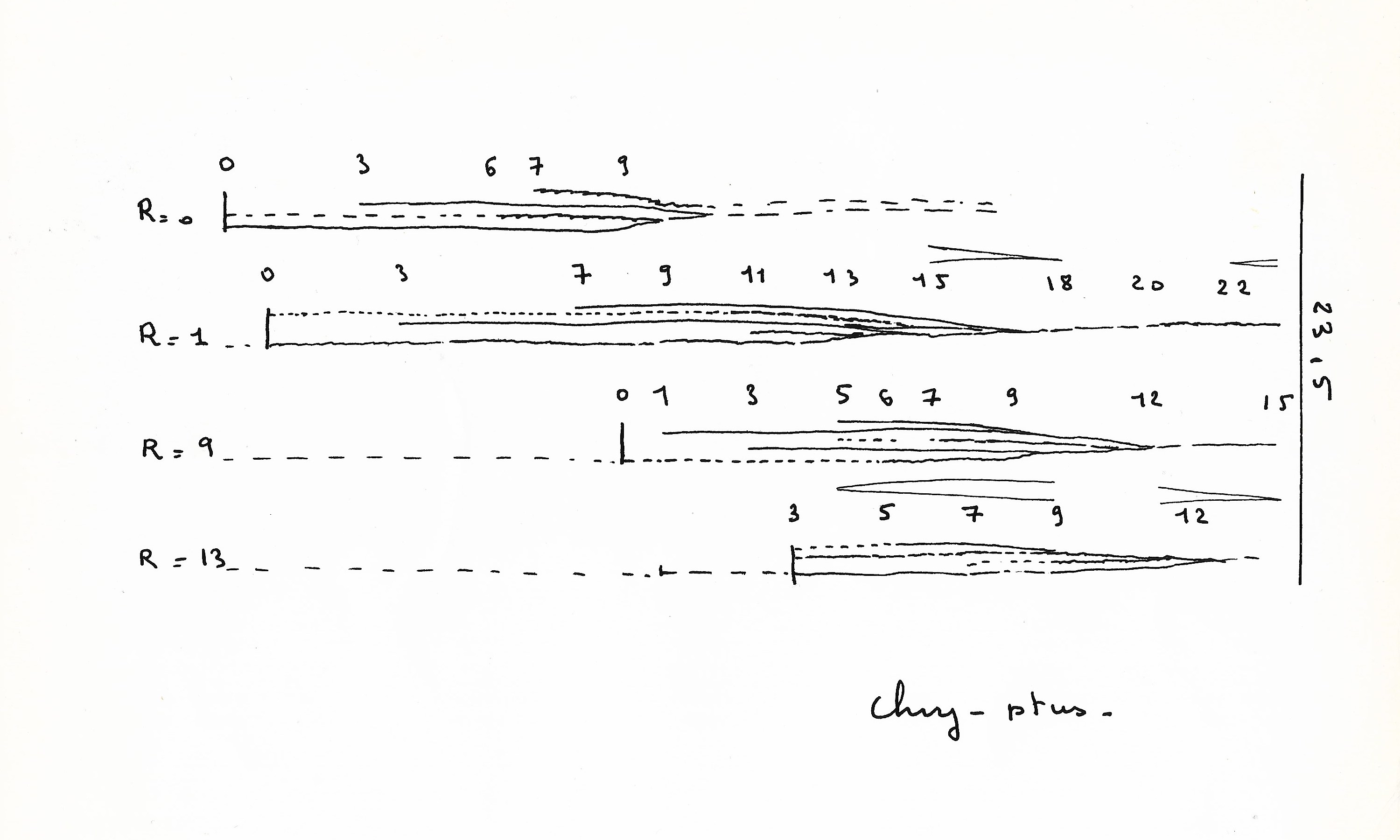Éliane Radigue: Vice-Versa, etc… and Chry-ptus
Éliane Radigue: Vice-Versa, etc… and Chry-ptus

Artists Space
New York, NY 10013
This 90 minute program highlights a turning point in Éliane Radigue’s career by presenting her final feedback piece, Vice-Versa, etc… (1970), alongside her first synthesizer piece, Chry-ptus (1971). Created less than a year apart from one another, the compositions share an interest in delicate control, sustained tones, and infinite variation while marking the beginning of a shift from the combination of asynchronous tapes to the imperceptible transitions between sound worlds that would become Radigue’s signature.
Between 1968 and 1970, Éliane Radigue created a series of works of variable and infinite duration in her home studio in Paris. Made with three tape recorders, a mixing board, an amplifier, two loudspeakers, and a microphone, Usral, Omnht, ? = a = b = a + b, and Vice-Versa, etc… consist of microphone and tape recorder feedback, reworked through studio techniques such as slowing down and reversal of direction. Recorded onto magnetic tape meant for simultaneous playback in loops of different durations, Radigue presented these eternally mutating works under the guise of Propositions Sonores in museums and galleries, anticipating the emerging practice of sound installation. Created in 1970 as a multiple in an edition of ten for the Lara Vincy Gallery in Paris, Vice-Versa, etc… was Radigue’s final feedback composition. It is comprised of a single magnetic stereo tape with hand-written instructions for diffusion suggesting that any combination of channels—right channel alone, left channel alone, or both channels together—can be overlapped, on several recorders, at any playback speed, forward or backward, ad libitum.
Chry-ptus is the very next piece in Radigue’s output, immediately following Vice-Versa, etc… It is also the first piece Éliane Radigue created with a synthesizer, in 1971, using a Buchla 100 modular system that had been installed by Morton Subotnick at NYU and which Radigue shared with Laurie Spiegel. Although seduced by the fact that the Buchla had no keyboard, Radigue was at first frustrated with the instrument’s effervescent output, spending her initial months eliminating everything she did not like before finding a small sonic zone she could use as an extension of her prior output. Transferring the delicate touch of her work with feedback to the Buchla’s beautifully rich sonority, Radigue worked with patches and potentiometers to create morphing textures that transitioned from fluttering beats to sustained low frequency tones and back again. In keeping with her earlier sound installation works, Chry-ptus was made with two reels of magnetic tape, to be played simultaneously through four loudspeakers with up to one minute of desynchronization -- essentially a canon at the unison. This subtle lapse produces tiny palpitations and new harmonic interplay to yield a variable music that is never exactly the same nor ever completely different. Chry-ptus was first presented in three variations on April 6th, 1971 in the auditorium of the New York Cultural Center.
Vice-Versa, etc… and Chry-ptus will be performed by Charles Curtis and Judith Hamann using newly produced reel-to-reel tape editions of the original masters, part of a series produced by Blank Forms in collaboration with Radigue for the high quality diffusion of her work.
Éliane Radigue (b. 1932) is a pioneering French composer of undulating continuous music marked by patient, virtually imperceptible transformations that purposively unfold to reveal the intangible, radiant contents of minimal sound—its partials, harmonics, subharmonics and inherent distortions. As a student and assistant to musique concrète pioneers Pierre Schaeffer and Pierre Henry in the ‘50s and ‘60s, Radigue mastered tape splicing techniques, but preferred the creation of fluid, delicately balanced feedback works to the spasmodic dissonance of her teachers’ music. Finding peers among minimalist composers in America, Radigue began working with synthesis in 1970, eventually discovering the ARP 2500 synthesizer, which she would use exclusively for her celebrated electronic works to come. With remarkable restraint, Radigue spent years on each piece, painstakingly assembling series of subtle, pulsating ARP recordings to be later mixed meticulously into hourlong suites of precise, perpetual mutation. In 2001, Radigue adapted an early feedback work to live performance on electric bass, Elemental II, and in 2004, with the encouragement of ongoing collaborator Charles Curtis, she permanently abandoned electronics for acoustic composition, beginning with Naldjorlak for solo cello, composed for Curtis. As within each individual work, Radigue has maintained an obstinate focus throughout the flow of her career, her dedication to the materiality of sound earning her numerous accolades and ensuring her place as one of the most important composers of our time.
Vice-Versa, etc… and Chry-ptus is part of Éliane Radigue: Intermediate States, a retrospective curated by Lawrence Kumpf and Charles Curtis and developed in collaboration with Éliane Radigue for Blank Forms in New York. The retrospective seeks to present Radigue’s practice in a richly contextualized, holistic manner to draw out important connections between her early and late periods of work, examining the breadth of her practice and juxtaposing her compositions with new interpretations and experimental re-stagings by contemporary composers. The retrospective will continue with more programs into 2020.
55 Walker St is accessible via elevator from street level, welcomes assistance dogs, and has wheelchair accessible non-gender-segregated toilet facilities. It is located within three blocks from the Canal St. 1, 2, A, C, E, J, Q, and R subway stops. For access inquiries please write to Blank Forms and we will make every effort to accommodate you.
Éliane Radigue: Intermediate States has been made possible by support from the New Music Fund, a program of FACE Foundation, with generous funding from the Cultural Services of the French Embassy in the United States, Florence Gould Foundation, Fondation CHANEL, French Ministry of Culture, Institut français-Paris, and SACEM (Société des Auteurs, Compositeurs et Editeurs de Musique).

